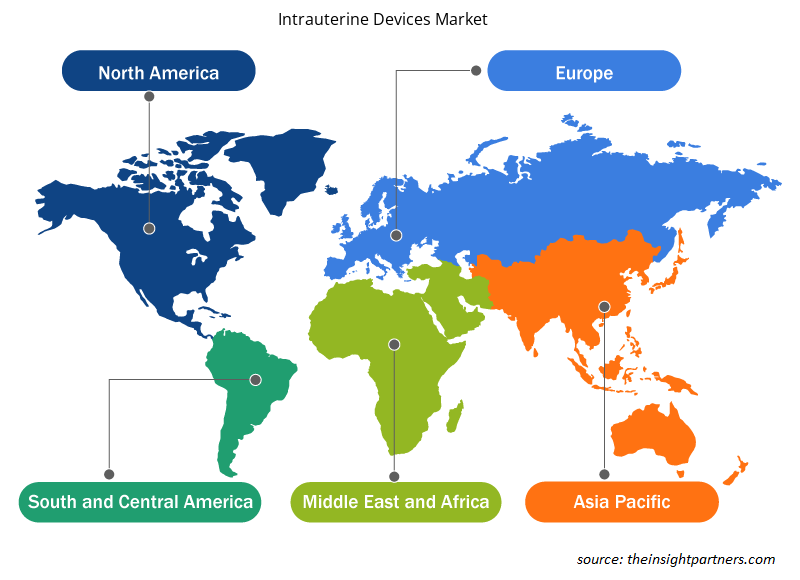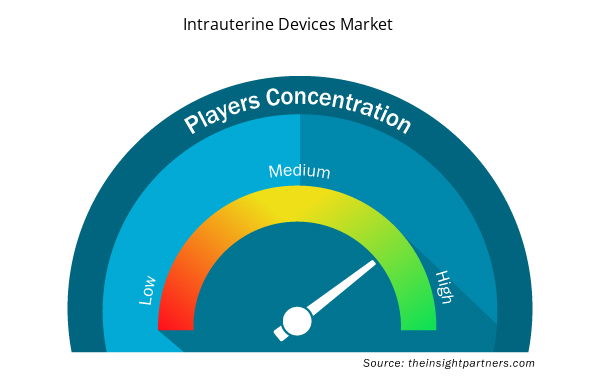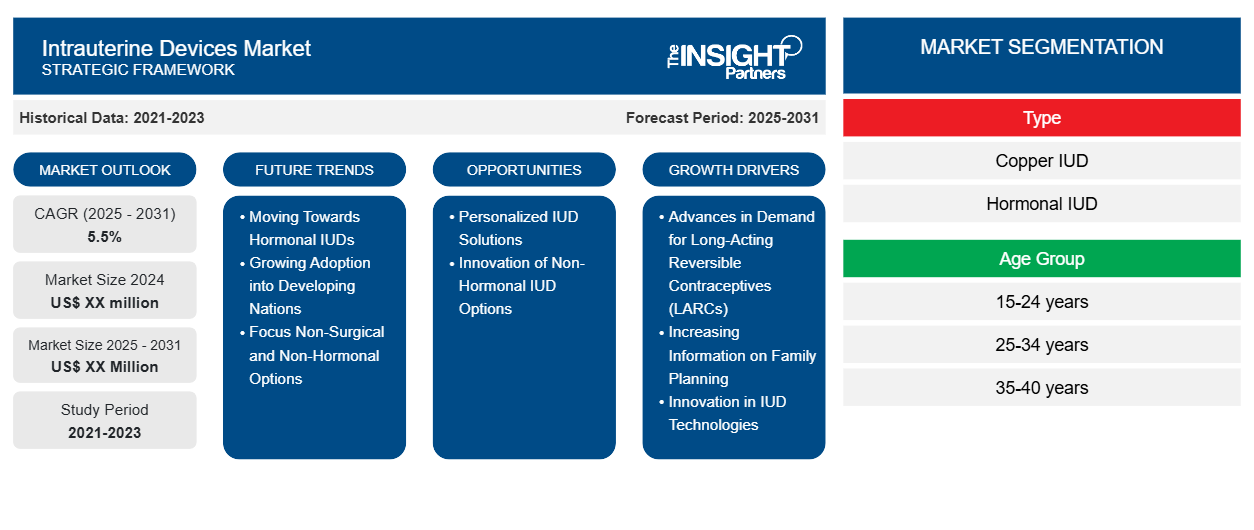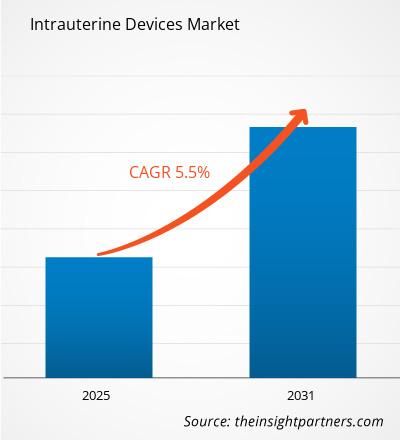子宮内避妊器具市場は、2023年から2031年にかけて5.5%のCAGRで成長し、市場規模は2023年のXX百万米ドルから2031年にはXX百万米ドルに拡大すると予想されています。
このレポートでは、タイプ (銅製 IUD、ホルモン IUD)、年齢層 (15〜24 歳、25〜34 歳、35〜40 歳、40 歳以上)、エンド ユーザー (病院、専門クリニック、その他) に基づいて分析を提示しています。グローバル分析は、地域レベルと主要国でさらに細分化されています。すべての主要な市場セグメントの市場規模と予測は、グローバル、地域、国レベルでカバーされています。レポートでは、上記の分析とセグメントの値を USD で提供しています。レポートでは、主要な市場プレーヤーの市場状況に関する主要な統計を提供し、市場の傾向と機会を示しています。
報告書の目的
The Insight Partners のレポート「子宮内避妊器具市場」は、現在の状況と将来の成長、主な推進要因、課題、機会を説明することを目的としています。これにより、次のようなさまざまなビジネス関係者に洞察が提供されます。
- テクノロジープロバイダー/メーカー: 進化する市場の動向を理解し、潜在的な成長機会を把握することで、情報に基づいた戦略的意思決定が可能になります。
- 投資家: 市場の成長率、市場の財務予測、バリュー チェーン全体に存在する機会に関する包括的な傾向分析を実施します。
- 規制機関: 市場の濫用を最小限に抑え、投資家の信用と信頼を維持し、市場の完全性と安定性を維持することを目的として、市場における政策と警察活動を規制します。
子宮内避妊器具市場のセグメンテーション
タイプ
- 銅製IUD
- ホルモン性IUD
年齢層
- 15~24歳
- 25~34歳
- 35~40歳
- 40歳以上
エンドユーザー
- 病院
- 専門クリニック
- その他
地理
- 北米
- ヨーロッパ
- アジア太平洋
- 南米と中央アメリカ
- 中東およびアフリカ
地理
- 北米
- ヨーロッパ
- アジア太平洋
- 南米と中央アメリカ
- 中東およびアフリカ
要件に合わせてレポートをカスタマイズする
このレポートの一部、国レベルの分析、Excelデータパックなど、あらゆるレポートを無料でカスタマイズできます。また、スタートアップや大学向けのお得なオファーや割引もご利用いただけます。
- このレポートの主要な市場動向を入手してください。この無料サンプルには、市場動向から見積もりや予測に至るまでのデータ分析が含まれます。
子宮内避妊器具市場の成長要因
- 長期作用型可逆性避妊薬 (LARC) の需要の高まり: IUD 市場を推進する主な要因は、長期作用型可逆性避妊薬の採用の増加です。今日、女性は効果的な「セットして忘れる」避妊法を求めるのではなく、毎日のモニタリングが不要な信頼性の高い IUD に最も惹かれるようになっています。したがって、世界的に永久的でありながら可逆的な避妊法のトレンドが高まっています。
- 家族計画に関する情報の増加: 家族計画器具に関する認識の向上により、IUD の需要と使用に対する関心が高まっています。一般の認識と教育のキャンペーン、および生殖医療へのアクセスの改善により、女性は安全で確実な避妊方法として IUD を選択するようになりました。この状況において、生殖権を求める国際運動の一環として、サチャ都市は開発途上地域および発展途上地域で IUD の需要を促進しています。
- IUD技術の革新: IUD技術の革新は、マイルを推進する推進力です。最も重要なのは、現代のIUDは初期のIUDに比べて不快感が少なく、挿入が簡単であることです。月経出血の減少などの追加のメリットがあるホルモン放出IUDなどの他の革新の結果、より多くの女性にとって魅力的になり、子宮内避妊器具の使用者数の増加が維持されています。
子宮内避妊器具市場の将来動向
- ホルモン IUD への移行: 市場では、ホルモン IUD が銅 IUD を上回り、徐々に普及しつつあります。このタイプの子宮内避妊器具には、月経が軽くなったり、月経痛が軽減されるなど、追加の利点があり、ユーザーを惹きつけています。その結果、この傾向は市場の動向を変え、ホルモンの健康にも役立つ避妊法を求める女性が増えています。
- 発展途上国での採用拡大: 子宮内避妊器具市場は、発展途上国でますます広く受け入れられています。生殖医療へのアクセス拡大とさまざまな避妊法に対する意識の高まりは、アジアやアフリカなどの多くの発展途上国が IUD 関連の成長に適しているとみなされる要因です。政府によって開始された家族計画イニシアチブと無数の NGO の取り組みも、IUD を使用する人々にとってこの市場の成長に貢献しています。
- 非外科的および非ホルモン的オプションに焦点を当てる: 銅製 IUD などの非侵襲的かつホルモンフリーの子宮内避妊器具への注目が高まっています。これらは、ほぼ自然な避妊法を求める女性です。長期避妊具としてのこの器具はホルモンを使用せずに利用可能で、ホルモンフリーのソリューションを好む人々に適しています。これにより、市場は、本当に非侵襲的でホルモンフリーの方法を求める女性へと移行しています。
子宮内避妊器具の市場機会
- パーソナライズされた IUD ソリューション: 子宮内避妊器具に関する個人のニーズへの資金調達には大きな余地があります。これらの IUD のパーソナライズされた機能は、サイズ、素材の好み、ホルモン含有量など、前述の専門分野をカバーするのに大いに役立ち、より多くの女性を対象とすることができます。そのため、選択肢が増え、快適性、有効性、満足度が高まり、さまざまな消費者グループによる採用が増えることになります。
- 非ホルモン性 IUD オプションの革新: ホルモンに基づかない避妊法を採用する女性が増えているため、先進的な銅製 IUD やその他の非ホルモン性避妊オプションの革新と商品化の機会が生まれています。したがって、非ホルモン性避妊法の需要が高まるにつれて、メーカーは長期的で非侵襲的な避妊法に対する需要の高まりの中で、より広い市場を享受する道が開かれることになります。
子宮内避妊器具市場の地域別分析
予測期間を通じて子宮内避妊器具市場に影響を与える地域的な傾向と要因は、Insight Partners のアナリストによって徹底的に説明されています。このセクションでは、北米、ヨーロッパ、アジア太平洋、中東、アフリカ、南米、中米にわたる子宮内避妊器具市場のセグメントと地理についても説明します。

- 子宮内避妊器具市場の地域別データを入手
子宮内避妊器具市場レポートの範囲
| レポート属性 | 詳細 |
|---|---|
| 2023年の市場規模 | XX百万米ドル |
| 2031年までの市場規模 | XX百万米ドル |
| 世界のCAGR(2023年~2031年) | 5.5% |
| 履歴データ | 2021-2022 |
| 予測期間 | 2024-2031 |
| 対象セグメント | タイプ別
|
| 対象地域と国 | 北米
|
| 市場リーダーと主要企業プロフィール |
|
子宮内避妊器具市場のプレーヤー密度:ビジネスダイナミクスへの影響を理解する
子宮内避妊器具市場は、消費者の嗜好の変化、技術の進歩、製品の利点に対する認識の高まりなどの要因により、エンドユーザーの需要が高まり、急速に成長しています。需要が高まるにつれて、企業は提供品を拡大し、消費者のニーズを満たすために革新し、新たなトレンドを活用し、市場の成長をさらに促進しています。
市場プレーヤー密度とは、特定の市場または業界内で活動している企業または会社の分布を指します。これは、特定の市場スペースに、その市場規模または総市場価値に対してどれだけの競合相手 (市場プレーヤー) が存在するかを示します。
子宮内避妊器具市場で事業を展開している主要企業は次のとおりです。
- アクタビス
- バイエル
- テバ製薬
- アラガン
- ANIファーマシューティカルズ
免責事項:上記の企業は、特定の順序でランク付けされていません。

- 子宮内避妊器具市場のトップキープレーヤーの概要を入手
主なセールスポイント
- 包括的なカバレッジ: レポートでは、子宮内避妊器具市場の製品、サービス、タイプ、エンドユーザーの分析を包括的にカバーし、全体的な展望を提供します。
- 専門家による分析: レポートは、業界の専門家とアナリストの深い理解に基づいてまとめられています。
- 最新情報: このレポートは、最新の情報とデータの傾向を網羅しているため、ビジネスの関連性を保証します。
- カスタマイズ オプション: このレポートは、特定のクライアント要件に対応し、ビジネス戦略に適切に適合するようにカスタマイズできます。
したがって、子宮内避妊器具市場に関する調査レポートは、業界の状況と成長の見通しを解読し理解する道の先導役となることができます。正当な懸念事項がいくつかあるかもしれませんが、このレポートの全体的な利点は欠点を上回る傾向があります。
- 過去2年間の分析、基準年、CAGRによる予測(7年間)
- PEST分析とSWOT分析
- 市場規模価値/数量 - 世界、地域、国
- 業界と競争環境
- Excel データセット



Report Coverage
Revenue forecast, Company Analysis, Industry landscape, Growth factors, and Trends

Segment Covered
This text is related
to segments covered.

Regional Scope
North America, Europe, Asia Pacific, Middle East & Africa, South & Central America

Country Scope
This text is related
to country scope.
よくある質問
Actavis, Bayer, Teva Pharmaceuticals, Allergan, ANI Pharmaceuticals
Growing Adoption into Developing Nations is likely to remain the key trend during the forecast period.
North America dominated the Intrauterine Devices Market in 2023
The Intrauterine Devices Market is estimated to witness a CAGR of 5.5% from 2023 to 2031
The market drivers include the Advances in Demand for Long-Acting Reversible Contraceptives (LARCs), Increasing Information on Family Planning, Innovation in IUD Technologies
Asia Pacific region is likely to witness the fastest growth rate during the forecast period.
Trends and growth analysis reports related to Life Sciences : READ MORE..
The Insight Partners performs research in 4 major stages: Data Collection & Secondary Research, Primary Research, Data Analysis and Data Triangulation & Final Review.
- Data Collection and Secondary Research:
As a market research and consulting firm operating from a decade, we have published and advised several client across the globe. First step for any study will start with an assessment of currently available data and insights from existing reports. Further, historical and current market information is collected from Investor Presentations, Annual Reports, SEC Filings, etc., and other information related to company’s performance and market positioning are gathered from Paid Databases (Factiva, Hoovers, and Reuters) and various other publications available in public domain.
Several associations trade associates, technical forums, institutes, societies and organization are accessed to gain technical as well as market related insights through their publications such as research papers, blogs and press releases related to the studies are referred to get cues about the market. Further, white papers, journals, magazines, and other news articles published in last 3 years are scrutinized and analyzed to understand the current market trends.
- Primary Research:
The primarily interview analysis comprise of data obtained from industry participants interview and answers to survey questions gathered by in-house primary team.
For primary research, interviews are conducted with industry experts/CEOs/Marketing Managers/VPs/Subject Matter Experts from both demand and supply side to get a 360-degree view of the market. The primary team conducts several interviews based on the complexity of the markets to understand the various market trends and dynamics which makes research more credible and precise.
A typical research interview fulfils the following functions:
- Provides first-hand information on the market size, market trends, growth trends, competitive landscape, and outlook
- Validates and strengthens in-house secondary research findings
- Develops the analysis team’s expertise and market understanding
Primary research involves email interactions and telephone interviews for each market, category, segment, and sub-segment across geographies. The participants who typically take part in such a process include, but are not limited to:
- Industry participants: VPs, business development managers, market intelligence managers and national sales managers
- Outside experts: Valuation experts, research analysts and key opinion leaders specializing in the electronics and semiconductor industry.
Below is the breakup of our primary respondents by company, designation, and region:

Once we receive the confirmation from primary research sources or primary respondents, we finalize the base year market estimation and forecast the data as per the macroeconomic and microeconomic factors assessed during data collection.
- Data Analysis:
Once data is validated through both secondary as well as primary respondents, we finalize the market estimations by hypothesis formulation and factor analysis at regional and country level.
- Macro-Economic Factor Analysis:
We analyse macroeconomic indicators such the gross domestic product (GDP), increase in the demand for goods and services across industries, technological advancement, regional economic growth, governmental policies, the influence of COVID-19, PEST analysis, and other aspects. This analysis aids in setting benchmarks for various nations/regions and approximating market splits. Additionally, the general trend of the aforementioned components aid in determining the market's development possibilities.
- Country Level Data:
Various factors that are especially aligned to the country are taken into account to determine the market size for a certain area and country, including the presence of vendors, such as headquarters and offices, the country's GDP, demand patterns, and industry growth. To comprehend the market dynamics for the nation, a number of growth variables, inhibitors, application areas, and current market trends are researched. The aforementioned elements aid in determining the country's overall market's growth potential.
- Company Profile:
The “Table of Contents” is formulated by listing and analyzing more than 25 - 30 companies operating in the market ecosystem across geographies. However, we profile only 10 companies as a standard practice in our syndicate reports. These 10 companies comprise leading, emerging, and regional players. Nonetheless, our analysis is not restricted to the 10 listed companies, we also analyze other companies present in the market to develop a holistic view and understand the prevailing trends. The “Company Profiles” section in the report covers key facts, business description, products & services, financial information, SWOT analysis, and key developments. The financial information presented is extracted from the annual reports and official documents of the publicly listed companies. Upon collecting the information for the sections of respective companies, we verify them via various primary sources and then compile the data in respective company profiles. The company level information helps us in deriving the base number as well as in forecasting the market size.
- Developing Base Number:
Aggregation of sales statistics (2020-2022) and macro-economic factor, and other secondary and primary research insights are utilized to arrive at base number and related market shares for 2022. The data gaps are identified in this step and relevant market data is analyzed, collected from paid primary interviews or databases. On finalizing the base year market size, forecasts are developed on the basis of macro-economic, industry and market growth factors and company level analysis.
- Data Triangulation and Final Review:
The market findings and base year market size calculations are validated from supply as well as demand side. Demand side validations are based on macro-economic factor analysis and benchmarks for respective regions and countries. In case of supply side validations, revenues of major companies are estimated (in case not available) based on industry benchmark, approximate number of employees, product portfolio, and primary interviews revenues are gathered. Further revenue from target product/service segment is assessed to avoid overshooting of market statistics. In case of heavy deviations between supply and demand side values, all thes steps are repeated to achieve synchronization.
We follow an iterative model, wherein we share our research findings with Subject Matter Experts (SME’s) and Key Opinion Leaders (KOLs) until consensus view of the market is not formulated – this model negates any drastic deviation in the opinions of experts. Only validated and universally acceptable research findings are quoted in our reports.
We have important check points that we use to validate our research findings – which we call – data triangulation, where we validate the information, we generate from secondary sources with primary interviews and then we re-validate with our internal data bases and Subject matter experts. This comprehensive model enables us to deliver high quality, reliable data in shortest possible time.


 このレポートの無料サンプルを入手する
このレポートの無料サンプルを入手する